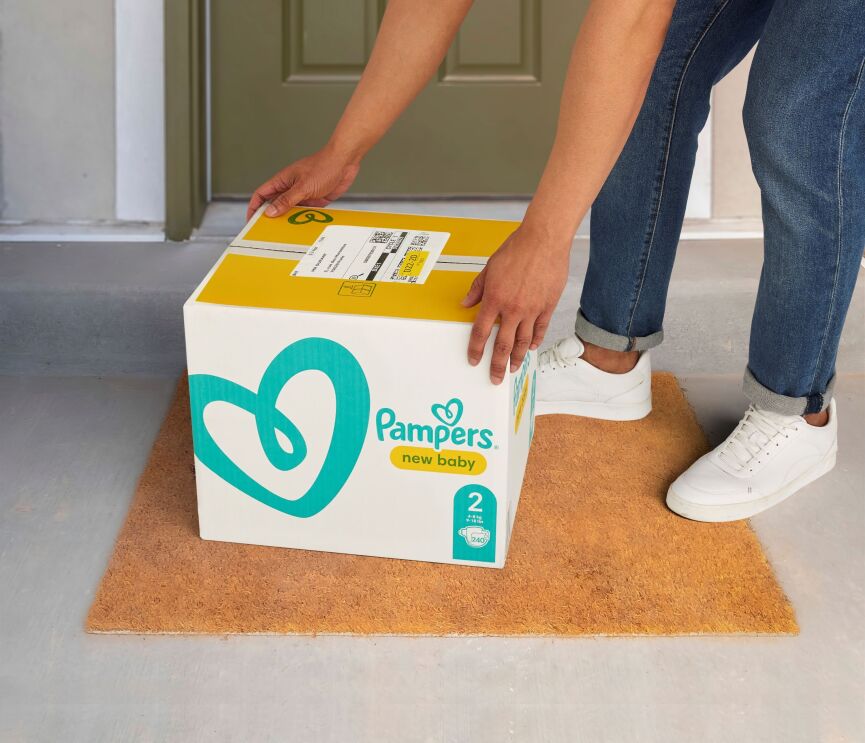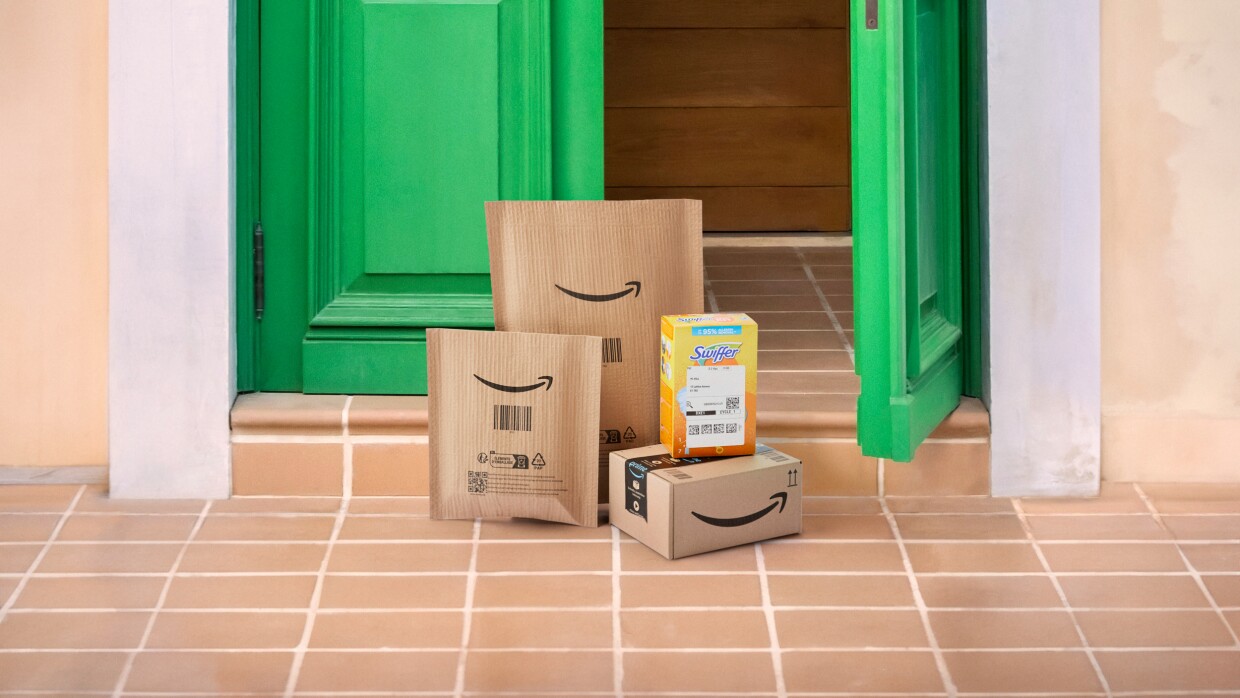We spend a lot of time thinking about the best way to deliver products to our customers, including how they’re packaged. And when it comes to the packaging, we start with protecting the product to ensure orders will arrive undamaged. From there, we find ways to use less packaging, while prioritising curbside recyclable materials.
Using a science-based approach, we find solutions that are good for both customers and the planet. In 2024, we’ve scaled innovations that work while inventing and testing new solutions to further our progress—and we’re proud of how far we’ve come. Below are some of our key global progress updates from our 2023 Sustainability Report:
- Total Packaging Reduction: In 2023, we avoided more than 446,000 metric tons of packaging. Since 2015, we’ve reduced the average per-shipment packaging weight by 43% and avoided a total of more than 3 million metric tons of packaging—the equivalent weight of nearly 285 of Seattle’s iconic Space Needle.
- Plastic Packaging Reduction: In 2023, we decreased our average plastic packaging weight per shipment by 9% across Amazon’s global operations network, building on a 17% reduction in 2022. Altogether, we’ve avoided 80,500 metric tons of single-use plastic packaging since 2020.
- Delivered without any Packaging: In 2023, we shipped 12% of our orders globally without any additional Amazon packaging.
Let’s take a closer look at the work our teams are doing globally to build on these achievements.
Shipping in product packaging

Our first priority is to remove packaging altogether when possible and we’ve found that sometimes the best solution is to use what already exists. Our Ships in Product Packaging programme tests and certifies products that can ship safely to customers in their original manufacturer’s packaging—without an additional Amazon box, envelope, or bag. This minimises the packaging used for delivery and allows packages to take up less space in delivery vehicles, increasing our truck fill rate.
Since 2019, more than 5.5 billion shipments were delivered without additional Amazon packaging in North America and Europe, and with nothing more than a shipping label. We use machine learning to identify products that will ship safely to customers this way, and work directly with selling partners to redesign their packaging so their products can test and certify for this reduced packaging programme. As a result of this innovative work, since 2019, more than 5.5 billion shipments were delivered without additional Amazon packaging in North America and Europe.
Initially the programme was primarily offered to vendors, but in February 2024, we expanded the programme to allow sellers to participate when using Amazon’s fulfilment network in North America and Europe. In 2024, nearly 4 million seller products were certified to ship in their own product packaging through seller engagement, machine learning, and product testing that helps identify qualifying products.
We continue to expand this programme across the globe. From 2021 to 2023, the number of products shipped without additional Amazon packaging grew by more than 50% in Japan and more than tripled in Australia.
Expanding paper-based packaging

When additional Amazon packaging is required to ship a product, we prioritise paper-based packaging solutions where possible. This packaging can often be recycled through home recycling pickup.
Across our European fulfilment network we replaced our single-use plastic delivery bags and air pillows with 100% recyclable paper and cardboard packaging that can be recycled in household recycling in 2022. In Europe, this—combined with other initiatives—has helped us avoid more than 1 billion single-use plastic delivery bags since 2019. Meanwhile, in India, we removed single-use, thin-film plastic packaging originating from Amazon’s fulfilment network in the country since 2020. In Japan, except for some services such as chilled or frozen products, we stopped packing items in single-use plastic delivery bags for orders from Amazon fulfilment centres.
As of October 2024, we’ve removed all plastic air pillows from our delivery packaging used at our global fulfilment centres. As part of this transition, we were able to quickly expand our use of paper filler made from 100% recycled content across North America to replace plastic air pillows, our biggest reduction in plastic packaging in North America to date.
We continue to innovate to create new paper-based packaging for our products, such as the new paper-padded envelope with a shock-absorbent, 100% paper-based lining, available in Europe. The ridged lining keeps products in the envelope safe, and absorbs stress put on the package during its journey to customers’ homes. This new paper-padded envelope is 100% recyclable in household recycling.
Scaling Innovations

In 2023 we announced our first U.S. automated fulfilment centre to fully eliminate single-use plastic delivery packaging. To do this, our engineers reimagined machinery that previously used plastic, and retrofitted the machines to use a new type of more durable, weather-resistant paper with heat-sealing technology. We also invented new machines with improved made-to-fit technology and transitioned from plastic air pillows to paper filler made from 100% recycled content. This was the first step in a multi-year effort to transition North America fulfilment centres to paper.
We have retrofitted more than 120 of our automated packing machines that made plastics bags to now create made-to-fit paper bags across the U.S. We implemented this in more than 20 fulfilment centres, helping us avoid more than 130 million plastic bags this year. Through our testing and learning, we have developed a new generation of this machine. Updates allow for us to pack larger products, helping to increase the number of products that can be packaged in paper bags by 20%. New sensors on the machine help us measure all dimensions of a product, allowing us to create more correctly sized packaging, reducing the amount of paper we use. Variations of this automated, packaging technology, which cuts made-to-fit paper bags for individual items, are being used in North America, Europe, Japan, and Australia.
We continue to reduce the amount of plastic per package. In December 2023, two-thirds of our shipments in North America included Amazon-added plastic delivery packaging and by December 2024, we aim to reduce this to a third.
Reducing packaging
When an item needs additional Amazon packaging to ensure a damage-free delivery, we aim to use as little packaging as possible. Amazon has designed and built models to determine the most efficient type of packaging for each item it learns about, helping reduce the number of cardboard boxes, filler, tape, and bags used. These models are already widely used in fulfilment centres in North America and Europe, with components being rolled out in additional locations across India, Australia, and Japan. For example, we often opt to use mailers and bags for delivery, which are up to 89% lighter than a similar-sized box. In 2023, in the U.S., Canada, and Europe, more than 50% of Amazon’s shipments were delivered in lightweight delivery packaging, such as bags or envelopes.
Looking ahead
We will continue to find ways to reduce packaging and increase the use of materials that can be easily recycled. We are committed to improving how orders are shipped, for the good of customers and the planet, and we will continue to share these progress updates with our customers.
Read more about Amazon’s overall sustainability efforts in our annual Sustainability Report.













